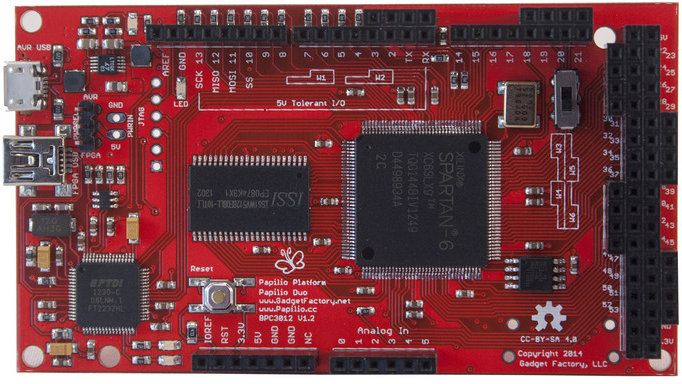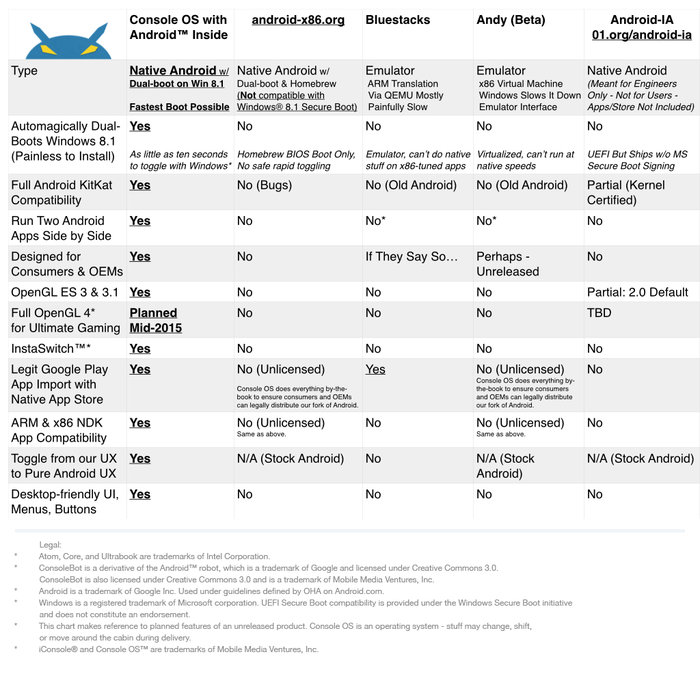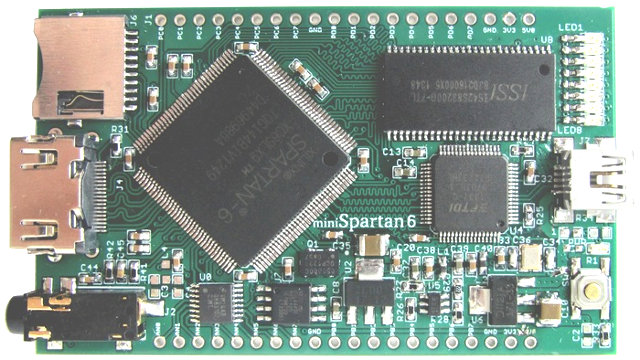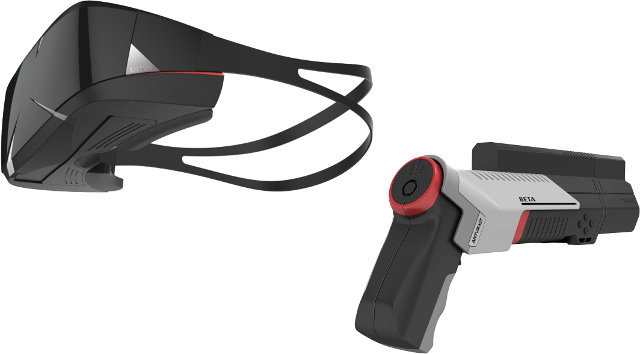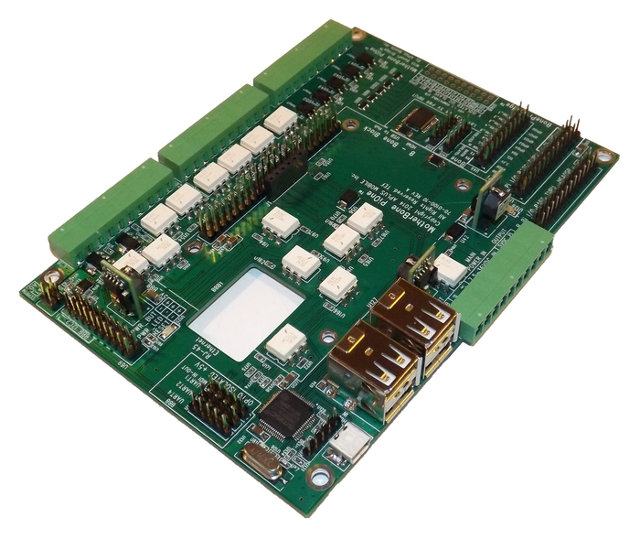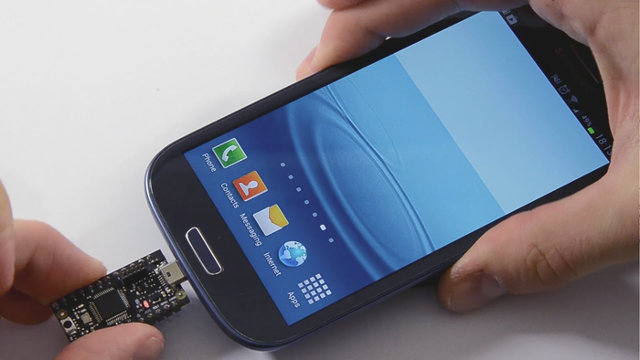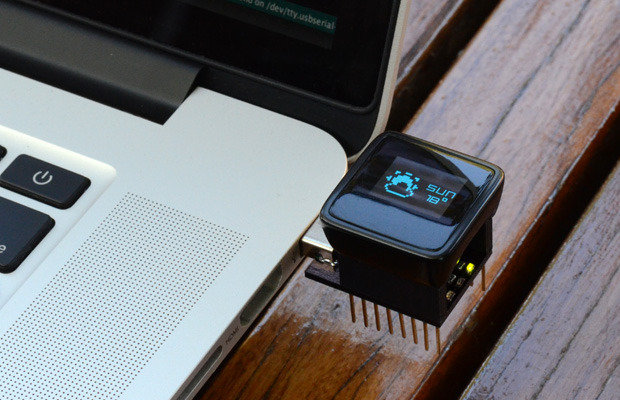In a concept similar to Arduissimo, Papilio DUO is an Arduino compatible board with a Xilinx Spartan-6 FPGA, but it adds a real Atmel AVR MCU, and instead of going the Indiegogo route, the project has launched on Kickstarter, and already reached its $30,000 funding target with 13 days to go. Instead of writing VHDL code, a drag and drop graphical tool called DesignLab will help you build your own circuits more easily. Let’s go through the hardware specifications first: FPGA – Xilinx Spartan 6 LX9 FPGA System Memory – 512KB or 2MB ISSI IS61WV5128 SRAM Storage – 64Mbit Macronix MX25L6445 SPI Flash MCU – Atmel AVR ATmega32U4 (Same as Arduino Leonardo) USB – 1x micro USB port connected to the Atmel MCU, 1x mini USB port connect to the FPGA I/Os 54 I/O pins available via Arduino Mega headers 0-16 Digital Pins connected to FPGA and ATmega32U4 JTAG Power – High […]
Console OS Aims to Run Android Alongside Windows on Intel based PCs, Laptops and Tablets (Crowdfunding)
There are already various solutions to run Android on Windows PC powered by Intel processors either going the emulator route, for example with BlueStacks or AndroVM (now Genimotion), or the native route with solutions such as Android-x86. So when I read Console OS, a port of Android capable of running along side of Windows, was looking for funds on Kickstarter to complete the project, I was perplex. But looking into details, it seems Console OS may indeed bring improvements to existing solutions, and Mobile Media Ventures, the company behind the project, released the following table comparing Console OS to other Android ports. If like me you had never heard of Andy Android, here’s the link to the project. Android IA is Intel ports of Android, which currently targets developers. So according to the developers, Console OS makes installing and dual-booting Android on a Windows PC easy, brings full Android Kitkat […]
$69 miniSpartan6+ Board with Xilinx Spartan 6 FPGA Features an HDMI Port (Crowdfunding)
I’ve already featured sub-$100 Xilinx Spartan 6 boards in this blog such as The Mojo and Arduissimo. There’s now another with Scarab Hardware‘s miniSpartan6+ which also includes an HDMI port, and is currently available for $69 on Kickstarter. This board could be used as a logic analyzer, a multimedia player, a game console emulator, an Arduino emulator, a stereo vision camera, and more. miniSpartan6+ specifications: FPGA- Xilinx Spartan6 LX9 System Memory – 32 MB SDRAM Storage – 64Mbit SPI Flash + micro SD card Video Output – HDMI Audio Output – Stereo audio output jack using 1-bit sigma-delta DAC USB – Micro USB OTG port Debugging – On-board USB JTAG programmer I/Os via breadboard friendly through holes 8-channel ADC running at 1 MSPS with 8 bit resolution. 24 Digital I/O pins. Misc – 8 LEDs. Dimensions – 4.57 x 7.62 cm Programming can be done with the company’s Scarab IDE, […]
ANTVR is a Full HD Virtual Reality Kit that Connects to Your PC or Game Console via HDMI or WHDI (Crowdfunding)
I must have heard about virtual reality for many years, even since I was a kid. But during that time, progress was slow, but it seems the time is ripe for virtual reality kits targeting consumers. The cheapest way to get started is with a smartphone adapter such as vrAse or Opendive, but if you want a possibly better experience using the power of your PC or game console you’ll want a more expensive kit such as Oculus Rift, or for developers, Oculus Rift Development Kit 2 that sells for $350. One possible downside of such kit is that it requires USB, HDMI and power cables, so it limits your mobility. ANTVR, a Beijing startup, will soon launch a virtual reality kit of the same name that will be available either with an HDMI cable, either without cable using WHDI (Wireless Home Digital Interface) with less than 1ms lag. The […]
MotherBone PiOne is a 3.5″ Industrial MotherBoard for the Raspberry Pi and the BeagleBone Black (Crowdfunding)
Many people are currently using low cost development boards such as the Raspberry Pi and Beaglebone Black in real products, and 3.5″ single board computers are commonly in industrial applications, so APlus Mobile, a US based company specialized in rugged industrial PCs, has decided to combine the two and designed MotherBone PiOne, a 3.5″ motherboard that can be used in conjunction with the Raspberry Pi and/or the Beaglebone Black for industrial projects. Let’s go through the specifications: SoC / Memory / HDMI and Ethernet – Via BeagleBone Black and/or Raspberry Pi single board computers (usable simultaneously) I/Os: 16-bit GPIO – 5V TTL level 16-bit GPIO (I2C Slave) I2C, I2C2 Bus – Individual BeagleBone Black and Raspberry Pi 5-pin I2C Master access with additional BeagleBone Black 5-pin I2C2 voltage isolated port Analog Inputs – 7x wide range analog voltage inputs with trim adjust for voltage range select PWM Output – Two […]
$14 Digispark Pro is a Tiny Arduino Ready Board Supporting over 25 Shields (Crowdfunding)
Digispark Pro is yet another small Arduino compatible board, but it costs only $14, and over 25 small form factor shields for Wi-Fi, BLE, mesh networking, etc.. are available for the platform. Let’s get straight into the hardware specs: MCU – AVR MCU @ 16 Mhz with 16KB Flash Memory (14.5K+ after bootloader) I/Os 14 I/O pins (2 shared with USB) I2C, true SPI, UART, LIN, and USI ADC on 10 pins 3 PWM Channels (which can be assigned to a selection of pins) USB – Micro USB for debugging, communication and power Misc – One button usable as reset, program, or user button, Power and Test/Status LEDs, user accessible solder jumpers to disable LEDs, and other features for lower power consumption Power – 5V via micro USB, or External Source – 5v or 6-16v (automatic selection). On-board 500ma 5V regulator Dimensions – 26.7mm x 18.3mm The board is compatible […]
USB2Go ARM Cortex M3 Development Board for Android Smartphones (Crowdfunding)
Many MCU based development boards such as Arduino or mbed platform connect to a computer via USB for power and programming, at least during the development stage. USB2Go, however, is designed with a micro USB port to connect directly to your Android smartphone, although it can also be used for standalone project, and an Arduino compatible baseboard is also available. This board powered by an STM32 ARM Cortex M3 MCU is however mainly destined to interface hardware such as LED, servos, sensors to your smartphone via micro USB providing both power and a communication channel with your Android device. USB2Go hardware specifications: MCU – STMicro STM32 ARM Cortex M3 MCU @ 72 MHz with 128 KB Flash, 64 KB SRAM USB – Micro USB for power and programming Headers – 2x 12 pin headers giving access to GPIO, ADC, PWM, UART, I2C, SPI… Debugging I/F – JTAG 20-pin to SWD […]
MicroView is a Tiny Arduino Compatible Board with an OLED Display (Crowdfunding)
Last year, we’ve been presented with many small Arduino compatible boards such as MicroDuino, RFDuino, BLEDuino, Spark Core, Olimexino-Nano and more… All these boards have been own strength and connectivity options, but if you want to see what going on in your board, you’d either need to connect it to your computer, or connect some LEDs or an external display. Geek Ammo’s MicroView fixes that by providing an Arduino compatible board nicely combined with a built-in OLED display. This allows you to display stats, weather, play games, create wearable projects (watch, necklace), and all sort of other projects that may require a small display. MicroView specifications: MCU – Atmel ATmega328P @ 16 MHz with 32KB flash, 2 KB SRAM, and 1KB EEPROM Display – 64×48 OLED Display Digital I/O – 12 (of which 3 provide PWM output) Analog Input – 6 Operating Voltage: 5V Input Voltage: 3.3VDC to 16VDC, no […]


